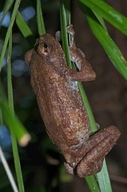|
Description
A large arboreal microhylid; 43-105 mm, males (45-88 mm) larger than females (43-61 mm). Back dark brown, sometimes with a light X-shaped figure. Sometimes a dark band between the eyes and a dark W-shaped figure on the scapular region. Venter is whitish but sometimes with dark spots. Skin on the back is granular. Nostrils slightly nearer to tip of snout than to the eye. Tympanum rather indistinct, about 1/3-1/2 of eye diameter. Tibiotarsal articulation reaches the tympanum. Fingertips very enlarged triangular. Toe 3 same length as, or slightly longer than, toe 5. Hands without webbing; webbing of the foot 1(1), 2i(2), 2e(1), 3i(2), 3e(1), 4i/e(2), 5(1) (Glaw and Vences 1994).
Similar Species: The largest Platypelis. The skin of Plethodontohyla inguinalis is smooth. Juveniles can be recognized by the granular skin and the greenish colour (Glaw and Vences 1994). Distribution and Habitat
Country distribution from AmphibiaWeb's database: Madagascar
Located in Ambolokopatrika (Andranomadio, Antsinjorano), Ambahaka forest, Ambatambe, Ampasimanolotra, Ampasinambo, Andasibe, Andohahela, Andrambovato, Andriamena, Anjanaharibe-Sud, Anjozorobe, Ankopakopaka forest, Antsihanaka, Ivohibe, Mandriandry forest, Manongarivo, Mantadia, Marojejy, Marovitsika, Midongy du Sud (Kilimagnarivo, Rozabe), Montagne d�Ambre, Nosy Mangabe, Ranomafana, Sahembendrana, Sambava, Tolagnaro, Tsararano, Vatoharanana (Ranomafana) (Glaw and Vences 2007). Occurs from sea level up to 1400m asl (Raxworthy et. al 2008).Life History, Abundance, Activity, and Special Behaviors
Habits: Usually found in large tree holes, or sometimes in Ravenala tree axils. Males larger than females and apparently territorial. Females deposit 90-100 eggs (diameter 4 mm) that are guarded by the males. Non-feeding tadpoles develop in the water of the tree holes. Juveniles metamorphose after five weeks and measure 7-8 mm (Glaw and Vences 2007).
Calls: A single resonating blow that reminds the chopping of wood and is repeated after irregular intervals (Glaw and Vences 2007).
Trends and Threats
Listed as least concern because of its wide distribution, tolerance of a degree of habitat modification, presumed large population, and because it is unlikely to be declining fast enough to qualify for listing in a more threatened category (Raxworthy et. al 2008).
Though it occurs in many protected areas, its forest habitat is receding due to subsistence agriculture, timber extraction, charcoal manufacture, and invasive spread of eucalyptus, livestock grazing and expanding human settlements (Raxworthy et. al 2008). Possible reasons for amphibian decline General habitat alteration and loss
Habitat modification from deforestation, or logging related activities
Intensified agriculture or grazing
Urbanization
Subtle changes to necessary specialized habitat
Comments
Taken with permission from Glaw and Vences (1994, 2007) and Raxworthy et. al (2008).
References
Glaw, F., and Vences, M. (2007). Field Guide to the Amphibians and Reptiles of Madagascar. Third Edition. Vences and Glaw Verlag, Köln.
Raxworthy, C., Cadle, J., and Andreone, F. (2008). Platypelis grandis. In: IUCN 2008. 2008 IUCN Red List of Threatened Species. www.iucnredlist.org. Downloaded on 22 April 2009.
Originally submitted by: Miguel Vences and Frank Glaw (first posted 2002-01-23)
Edited by: Catherine Aguilar (2010-07-18)Species Account Citation: AmphibiaWeb 2010 Platypelis grandis <https://amphibiaweb.org/species/2338> University of California, Berkeley, CA, USA. Accessed Nov 27, 2024.
Feedback or comments about this page.
Citation: AmphibiaWeb. 2024. <https://amphibiaweb.org> University of California, Berkeley, CA, USA. Accessed 27 Nov 2024.
AmphibiaWeb's policy on data use.
|
